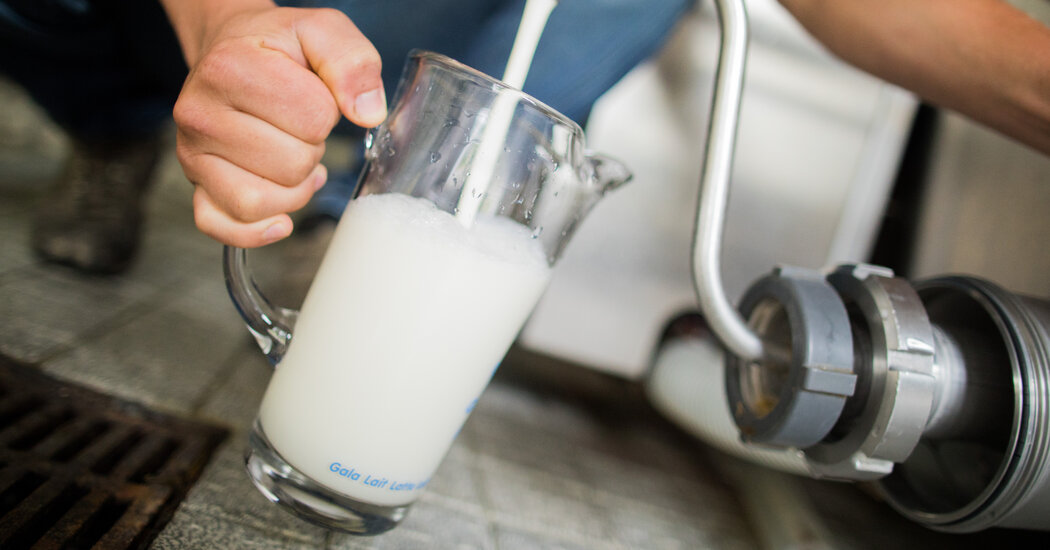Testing suggests that pasteurization inactivates the virus. But what about raw milk and cheese?
While maintaining that avian influenza poses a low risk to the general public, health officials again warned on Wednesday about the potential risk of unpasteurized milk.
“We continue to strongly advise against the consumption of raw milk,” Dr. Donald Prater, acting director of the Center for Food Safety and Applied Nutrition at the Food and Drug Administration, said at a news conference.
Raw milk, in the best of times, “is one of the one of the riskiest foods that we have,” said Benjamin Chapman, a professor and food safety specialist at North Carolina State University. But with cases of avian influenza, or bird flu, detected in dairy cows, it could potentially be even riskier now, health experts warn.
Nearly all of the dairy milk sold in stores is pasteurized, and testing by the F.D.A. has so far shown that this process inactivates the avian influenza virus H5N1.
If you’re consuming pasteurized milk or dairy products, “I’m confident the risk is extraordinarily low at this point,” said Dr. Dean Blumberg, chief of pediatric infectious diseases at UC Davis Health.
Raw milk, on the other hand, isn’t pasteurized and can contain dangerous germs. While the Food and Drug Administration has long recommended consumers avoid drinking it, more than two dozen states have legalized the sale of raw milk.
The same bacteria that commonly cause food-borne illnesses, like salmonella, E. coli and listeria, can fester in raw milk. Between 1998 and 2018, researchers linked over 200 outbreaks, which sickened 2,645 people and led to 228 hospitalizations, to raw milk. People who are very young or very old, are pregnant or have compromised immune systems are particularly likely to get seriously ill from the pathogens in raw milk, said Darin Detwiler, a food safety expert and professor at the College of Professional Studies at Northeastern University.
Can you catch bird flu from raw milk?
Dr. Rosemary Sifford, deputy administrator of veterinary services at the Department of Agriculture, said in the Wednesday briefing that testing has found a “high viral load” in raw cow’s milk, and that federal officials believe that the primary way the virus is spreading between cows is through contact with milk. Government agencies are continuing to test samples from affected herds, according to the F.D.A.
Researchers and health officials are not sure whether bird flu can spread from raw milk to humans.
“There’s not a tremendous amount of studies showing the infectivity related to this virus and raw milk products,” Dr. Prater said. But, he said, agencies are continuing to monitor the issue as new research emerges.
On Wednesday, the F.D.A. said it “recommends that industry does not manufacture or sell raw milk or raw milk products.” The agency has also recommended producers discard milk from affected cows and pasteurize raw milk from exposed cattle before feeding it to animals.
Some researchers think it is unlikely that bird flu can transmit to humans through raw milk, but Dr. Meghan Davis, a veterinarian and environmental epidemiologist at the Johns Hopkins Bloomberg School of Public Health, said that she was concerned about this possibility, in part because cats on dairy farms have been sickened by the virus.
In a study published Monday, researchers described a group of about two dozen cats that were fed raw milk from cows with avian influenza on a Texas dairy farm. More than half of the cats became ill and died; two of the deceased cats were tested and found to have been infected with the virus. It’s possible they were sickened by eating wild birds, but raw milk was “a likely route of exposure,” the researchers wrote.
Dr. Blumberg noted that other influenza viruses that typically affect humans can spread if people touch surfaces contaminated with the virus and then touch their mouths, noses or eyes. Avian influenza may spread similarly, he said, including through handling or consuming contaminated raw milk or cheese.
There have been only two cases of avian influenza in humans reported in the United States since 2022; both people were exposed to infected animals and had mild illnesses. But the virus has caused severe illness in humans in the past, Dr. Blumberg said.
What about cheeses made from raw milk? Or goat’s milk?
Some cheese-making processes can involve higher temperatures and pressures, which could inactivate the virus in raw milk, Dr. Davis said. Other steps, such as aging, could also affect virus survival. But at this stage, Dr. Davis said, it’s hard to know how risky any given raw-milk cheese might be.
It’s also worth being cautious about raw-dairy products from goats or sheep, Dr. Davis said. Avian influenza was detected in young goats on a Minnesota farm in March; and while there haven’t yet been cases reported in sheep, it’s plausible that they could contract the virus, too, she added.
How widespread is the virus?
As of April 27, the U.S. Department of Agriculture had confirmed cases of avian influenza in dairy cows in nine states. But just because the virus hasn’t been reported in a state it doesn’t mean that it’s not there, Dr. Davis said. The F.D.A. has reported finding inactive fragments of the virus in about 20 percent of pasteurized-milk samples from around the country, suggesting that the virus has spread more than animal testing has indicated, she said.
“We don’t yet have a good grasp of just how widespread it is,” Dr. Davis said.
Since wild birds can spread the virus, small farms can be affected as well as large ones, she said.
“The precautionary approach would be to avoid raw-dairy products” altogether for the time being, Dr. Davis said. “We have so many unknowns.”
